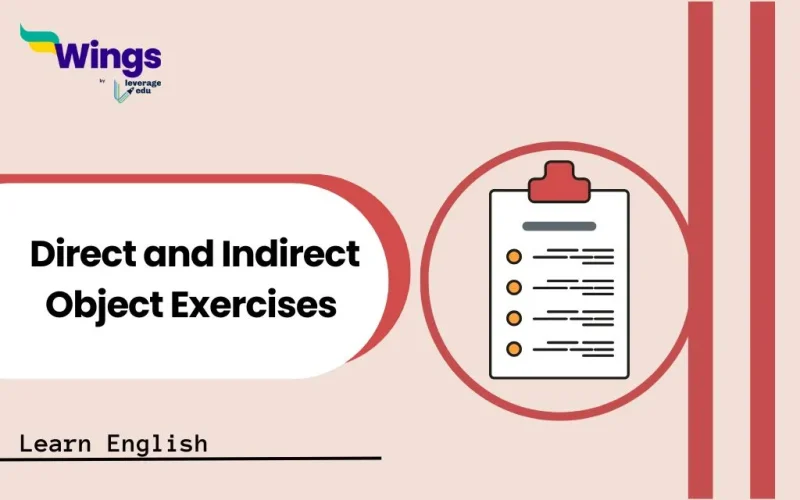Direct and Indirect Object exercises: When learning English, one of the most important concepts to master is the use of direct and indirect objects in sentences. These elements add clarity, meaning, and structure to our communication. If you’ve ever been confused about identifying them, don’t worry! In this blog post, we’ll break it down in an easy-to-understand way, provide unique insights, and offer some simple direct and indirect object exercises to test your knowledge.
This Blog Includes:
What Are Direct and Indirect Objects?
Direct and indirect objects are essential parts of a sentence that help clarify who or what is affected by the action. Understanding them makes your sentences clearer and more precise.
| Object | Defination | Example |
| Direct Object | A direct object is the noun or pronoun that directly receives the action of the verb. | She bought a book. (“Book” is the direct object because it is receiving the action of “bought.”) |
| Indirect Object | An indirect object is the noun or pronoun that receives the direct object. It usually answers the question “to whom?” or “for whom?” something is done. | She gave her friend a gift.(“Friend” is the indirect object because the gift is being given to her friend.) |
Must Read: Direct and Indirect Objects Definition with Examples and Exercises
How to Identify Direct and Indirect Objects?
Identifying direct and indirect objects is simple if you follow a step-by-step approach. Just locate the verb, find what receives the action, and determine who benefits from it.
- Find the verb: What is the action in the sentence?
- Find the direct object: Ask “what?” or “whom?” after the verb.
- Find the indirect object: Ask “to whom?” or “for whom?” the action is done.
Example: I sent my sister a postcard.
- Verb: sent
- Direct Object: a postcard (What was sent?)
- Indirect Object: my sister (To whom was the postcard sent?)
Check out: Subject and Predicate Exercise with Answers
Direct and Indirect Objects Exercises
Try these direct and indirect object exercises to strengthen your grasp of direct and indirect objects.
Exercise 1: Identify the Direct and Indirect Objects
Find the direct and indirect objects in the following sentences:
- He sent his friend an invitation.
- They offered me a job.
- She handed the teacher her homework.
- My brother made me a sandwich.
- We showed the guests their rooms.
- She wrote her grandmother a letter.
- The coach gave the players some advice.
- I bought my sister a new dress.
- He passed his colleague the document.
- We sent our professor an email.
Answers:
- Direct object: an invitation
- Indirect object: his friend
- Direct object: a job
- Indirect object: me
- Direct object: her homework
- Indirect object: the teacher
- Direct object: a sandwich
- Indirect object: me
- Direct object: their rooms
- Indirect object: the guests
- Direct object: a letter
- Indirect object: her grandmother
- Direct object: some advice
- Indirect object: the players
- Direct object: a new dress
- Indirect object: my sister
- Direct object: the document
- Indirect object: his colleague
- Direct object: an email
- Indirect object: our professor
Exercise 2: Fill in the Blanks
Complete the sentences with suitable direct and indirect objects:
- The waiter brought ____ (direct object) ____ (indirect object).
- She told ____ (indirect object) ____ (direct object).
- They gave ____ (indirect object) ____ (direct object).
- I sent ____ (indirect object) ____ (direct object).
- He lent ____ (indirect object) ____ (direct object).
- The teacher showed ____ (indirect object) ____ (direct object).
- She offered ____ (indirect object) ____ (direct object).
- We bought ____ (indirect object) ____ (direct object).
- He gave ____ (indirect object) ____ (direct object).
- I wrote ____ (indirect object) ____ (direct object).
Possible answers:
- The waiter brought us (indirect object) the menu (direct object).
- She told me (indirect object) a story (direct object).
- They gave her (indirect object) a gift (direct object).
- I sent him (indirect object) a letter (direct object).
- He lent me (indirect object) a book (direct object).
- The teacher showed the students (indirect object) a diagram (direct object).
- She offered me (indirect object) a job (direct object).
- We bought her (indirect object) a present (direct object).
- He gave his friend (indirect object) some advice (direct object).
- I wrote her (indirect object) a note (direct object).
Also Read: Subject vs Predicate: Types, Examples, Practice Questions
Pro Tips for Remembering Direct and Indirect Objects
A few simple tricks can make identifying objects easier. Focus on the verb, ask the right questions, and watch for keywords like “to” or “for.”
- Check the verb: Action verbs often take a direct object.
- Ask the right questions: “What?” for the direct object, “To/For whom?” for the indirect object.
- Look for “to” or “for”: These words often indicate an indirect object.
By practicing regularly, you will soon find it easy to recognise and use direct and indirect objects naturally. Keep practicing with different sentences, and before you know it, you will be a pro at identifying these essential grammar elements nd solving direct and indirect object exercises.
Check more worksheets on different English Grammar topics here:
FAQs on Direct and Indirect Object Exercises
A direct object receives the action of the verb, while an indirect object tells to whom or for whom the action is done.
Yes, a sentence can have just a direct object. For example, in the sentence ‘She read a book,’ there is no indirect object.
To identify the direct object in a sentence, first locate the verb and ask “what?” or “whom?” after it. The direct object receives the action of the verb. It is usually a noun or pronoun. For example, in “She bought a book,” the verb is “bought,” and “book” is the direct object.
To find the indirect object, first identify the verb and direct object by asking “what?” or “whom?” after the verb. Then, ask “to whom?” or “for whom?” the action is done. For example, in “She gave her friend a gift,” “gift” is the direct object, and “her friend” is the indirect object.
Yes, an indirect object can come after a direct object when it is used with a preposition such as “to” or “for.” This structure is common in English.
For example, “She gave a gift to her friend.”
Identify the verb: The verb is “gave” (action being performed).
Find the direct object: Ask “What did she give?” – “a gift” (this receives the action of the verb).
Find the indirect object: Ask “To whom did she give the gift?” – “to her friend” (this is the recipient of the direct object).
Here, the indirect object “her friend” comes after the direct object “a gift” because it follows the preposition “to.”
No, not all sentences have both direct and indirect objects. A sentence must have a transitive verb to take a direct object, and an indirect object only appears when something is given, sent, or done for or to someone.
We hope these direct and indirect object exercises were helpful to you. For more information on English grammar and the English language, stay tuned to the Learn English page of Leverage Edu.
 One app for all your study abroad needs
One app for all your study abroad needs















 45,000+ students trusted us with their dreams. Take the first step today!
45,000+ students trusted us with their dreams. Take the first step today!


